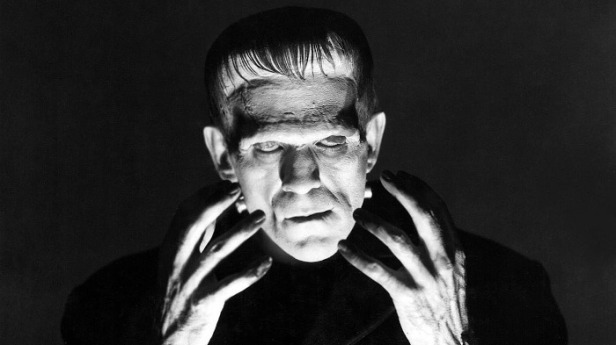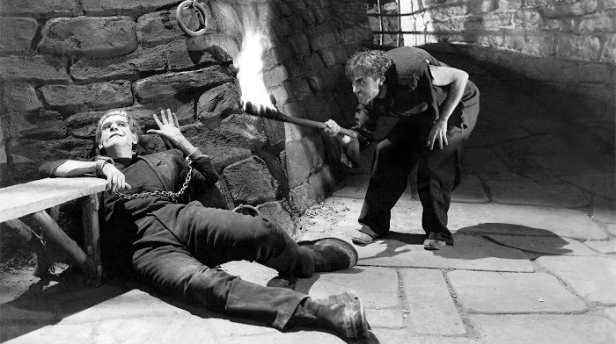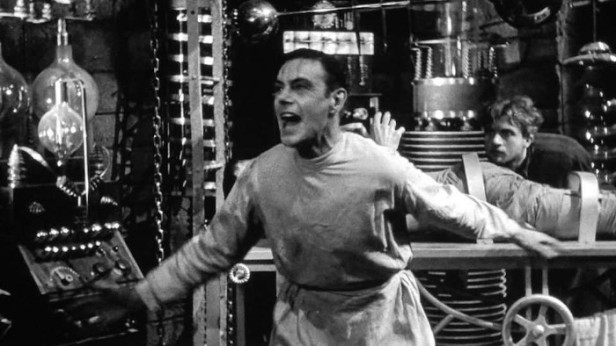The first undisputed masterpiece of Universal horror’s classic horror era, it dramatically alters the original story by “Mrs Percy B. Shelley” as the credits refer to Mary, and in doing so, became the default version of the tale for so many. Individual scenes, the overall ambience and the way the story is told has continued to influence the horror film all these decades later.
The film opens with Edward Van Sloan stepping out from behind a curtain to talk directly to the audience, cautioning them about what they’re about to see (“so, if any of you feel that you do not care to subject your nerves to such a strain, now’s your chance to… well, we warned you.”) The first shot proper is a grim tableau of sobbing mourners and sombre priests attending a funeral on a surreal studio-bound set, watched over at a distance by Henry Frankenstein (Colin Clive), his hunchbacked assistant Fritz (Dwight Frye) and a skull-faced, cowled guardian statue. Frankenstein is after bodies for his latest experiment in piecing together a human body from parts stolen from hanged men and the recently buried.

The studio-set graveyard and gallows sets the dreamlike tone of the film, a feeling underlined further when we visit Frankenstein’s laboratory, built inside a colossal watchtower. Frankenstein despatches Fritz to steal a brain for his creation, but the clumsy assistant damages the good one and returns with the corrupted brain taken from the body of a hanged criminal. Henry’s fiancée Elizabeth (Mae Clark) is concerned about his increasingly strange behaviour and she and his friend Victor Moritz (John Boles) persuade Frankenstein’s tutor Dr Waldman (Van Sloan) to join them in visiting the laboratory. The arrive in time to see a rapturous Frankenstein bring his creation to life using the electricity from a raging storm, still a quite extraordinary scene – an exultant Frankenstein cries “it’s alive!” before delivering a much-censored cry of “in the name of God! Now I know what it feels like to be God!”
The monster (Boris Karloff) is grotesque in appearance but strangely naive and innocent, but after being tormented by Fritz it murders him and escapes into the surrounding countryside where it inadvertently kills a young girl, Maria (Marilyn Harris) before returning to Frankenstein’s home to gate-crash his wedding to Elizabeth. The locals form one of cinema’s great – and earliest – torch-wielding mobs to hunt for the monster, finally cornering it in a windmill into which it drags Frankenstein. The fiery climax – one of the very best sequences in any Universal horror film – sees Frankenstein fall to injury but safety and the monster apparently perish in the flames. The film’s final words – “here’s to a son to the house of Frankenstein” points the way for two future films in the series.

Thanks to director James Whale’s sly sense of jet-black humour, there’s an irreverence about Frankenstein that both the Universal versions of Dracula had lacked. There’s little of the droll humour that Whale would bring to Bride of Frankenstein (1935), but there’s a playfulness about some of the film that Whale would explore to even better effect in subsequent films. Here, Frederick Kerr’s aging Baron provides much of the comic relief, but Whale hasn’t yet quite worked out how to properly balance the scares and the laughs. It was later spoofed, brilliantly, by Mel Brooks in the excellent Young Frankenstein (1974) and one would like to think that Whale would have enjoyed that film’s fond lampooning and sheer absurdity.
Karloff is simply amazing. As Lugosi’s image of Dracula has become definitive for so many, so Karloff’s monster is generally the one most people picture when they hear the name Frankenstein. Jack Pierce’s remarkable make-up, giving the monster a flattened head with two bolts either side of its neck, would be ripped off, homaged and parodied time and again in the years and decades to come. Yet for all its grim appearance and despite the fact that the monster backing into the laboratory for its first reveal is somewhat contrived, the jump cuts into that ghastly face, with its hooded eyes, scarred forehead and sunken cheeks is about as iconic an image as any in the horror genre. But it’s to Karloff’s eternal credit that beneath that hideous exterior, he allows us glimpses of the childlike “monster” that lies within (its fascination with the sun, it’s wanting to play with Maria, a scene as heart-rending as it is horrifying), a tragic figure so beautifully played by Karloff.

He’s so good that it’s sometimes easy to overlook just how strong the supporting cast is. Clive in particular is terrific, never more so than in the “God” speech and Clarke makes for a fetching heroine. Frye adds to his growing gallery of grotesques, following up the mad Renfield in Dracula with the stooped, not-terribly-bright Fritz, bent double, walking with the aid of a short stick, initially prompting a degree of sympathy for his condition but later revealing himself to be a petty-minded sadist who takes undue joy in torturing the monster. Only Kerr is an annoyance, his buffoonish ramblings and jokey demeanour fitting ill with the Gothic trappings around him.
It’s still an extraordinary looking film to this day, thanks in equal part to its vivid camerawork, beautiful framing and atmospheric lighting (all courtesy of Arthur Edeson and an uncredited Paul Ivano), stunning, towering sets and those atmospheric fake exteriors (designed by Charles D. Hall) and those immortal electrical gizmos that bring both the laboratory and the monster to life (built by Kenneth Strickfaden). Its visual vocabulary has been adopted, adapted and appropriated so many times since that it’s easy to forget that this is ground zero – it was, in a sense, the birth of the horror film as we’ve come to understand it – you can almost see the genre taking shape as film goes along.

Frankenstein pushed the envelope of acceptability to breaking point and beyond, earning the displeasure of censors almost everywhere. The “now I know what it feels like to be God!” fell foul of censors in several US states (Kansas reportedly initially wanted 32 cuts to the film), and the film was banned outright in some countries. But it was the killing of Maria that upset authorities the most. Universal decided to cut the precious camera negatives to tone down the offending scene and for many years it was only available in a compromised version, until the missing footage was found tucked away in the BFI’s National Film Archive in the 1980s and restored.
James Whale proved to be one of screen horror’s greatest assets. With Frankenstein, The Old Dark House (1932), The Invisible Man (1933) and Bride of Frankenstein he set the bar, particularly for the Universal horrors, almost impossibly high. Frankenstein remains a masterpiece of the genre, the first truly great Universal horror, and it was a pity that after Bride he left the world of horror and never returned. The Universal Frankenstein series continued with sequels Son of Frankenstein (1939), The Ghost of Frankenstein (1942), Frankenstein Meets the Wolf Man (1943), House of Frankenstein (1944) and House of Dracula (1945), before the monster helped to kick off a series of spoofs with Abbott and Costello Meet Frankenstein (1948). Most of them are fun, but none of them have the macabre atmosphere or grimly fiendish sense of humour that Whale brought to the first two films.
Crew
Directed by: James Whale; Copyright MCMXXXI [1931] by Universal Pictures Corp. Carl Laemmle Pres.; Universal Pictures. Carl Laemmle presents; Produced by: Carl Laemmle Jr; Screen Play: Garrett Fort, Francis Edward Faragoh; Based upon the composition by: John L. Balderston; From the Novel by: Mrs Percy B. Shelley; Adapted from the Play by: Peggy Webling; Cinematographer: Arthur Edeson; Supervising Film Editor: Maurice Pivar; Film Editor: Clarence Kolster; Music: Bernhard Kaun [uncredited]; Recording Supervision: C. Roy Hunter; Costumes: Ed Ware [uncredited], Vera West [uncredited]; Make Up: Jack P. Pierce [uncredited]; Special Effects: John P. Fulton [uncredited]; Electrical Properties: Ken Strickfaden [uncredited]; Art Director: Charles D. Hall
Cast
Colin Clive (Henry Frankenstein); Mae Clarke (Elizabeth); John Boles (Victor Moritz); ? [in opening credits] Boris Karloff [in end credits] (the monster); Edward Van Sloan (Doctor Waldman); Frederick Kerr (Baron Frankenstein); Dwight Frye (Fritz); Lionel Belmore (Herr Vogel the Burgomaster); Marilyn Harris (little Maria); Michael Mark [Ludwig, Maria’s father – uncredited]; Joseph North [butler – uncredited]; Cecilia Parker [maid – uncredited]; Arletta Duncan, Pauline Moore [bridesmaids – uncredited]; Maidel Turner [housekeeper – uncredited]; William Yetter [gendarme – uncredited]; Francis Ford, Paul Panzer, Inez Palange, Ted Billings, Harry Tenbrook [villagers – uncredited]; Cecil Reynolds [university secretary – role deleted]
For one of the most original stories and films about the consequences of meddling with nature, we can always embrace Frankenstein as one of the landmarks of the sci-fi and horror cinema. Thanks for your review.
LikeLiked by 2 people
Love this movie. Love Karloff, but the rest hold up, too. Baron Frankenstein is a fun hoot! Got to watch this – and Dracula – on the big screen yesterday. Such a treat!
LikeLiked by 2 people